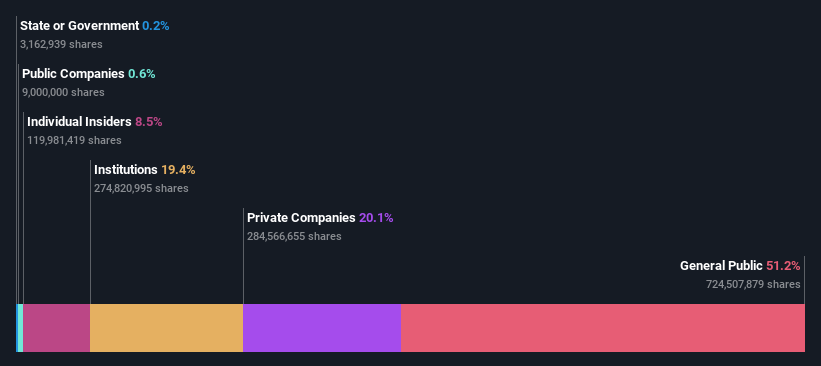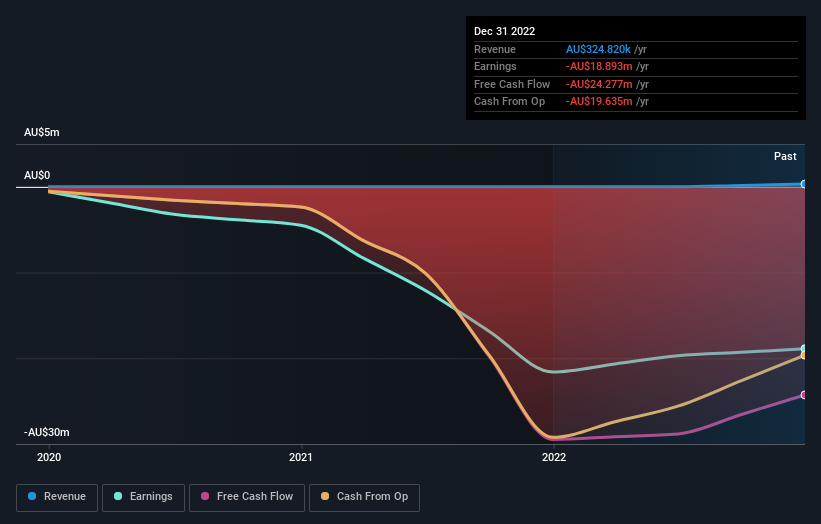While private companies own 20% of Burgundy Diamond Mines Limited (ASX:BDM), retail investors are its largest shareholders with 51% ownership
Key Insights
The considerable ownership by retail investors in Burgundy Diamond Mines indicates that they collectively have a greater say in management and business strategy
45% of the business is held by the top 25 shareholders
To get a sense of who is truly in control of Burgundy Diamond Mines Limited (ASX:BDM), it is important to understand the ownership structure of the business. The group holding the most number of shares in the company, around 51% to be precise, is retail investors. That is, the group stands to benefit the most if the stock rises (or lose the most if there is a downturn).
Meanwhile, private companies make up 20% of the company’s shareholders.
Let's delve deeper into each type of owner of Burgundy Diamond Mines, beginning with the chart below.
Check out our latest analysis for Burgundy Diamond Mines
What Does The Institutional Ownership Tell Us About Burgundy Diamond Mines?
Institutions typically measure themselves against a benchmark when reporting to their own investors, so they often become more enthusiastic about a stock once it's included in a major index. We would expect most companies to have some institutions on the register, especially if they are growing.
Burgundy Diamond Mines already has institutions on the share registry. Indeed, they own a respectable stake in the company. This suggests some credibility amongst professional investors. But we can't rely on that fact alone since institutions make bad investments sometimes, just like everyone does. If multiple institutions change their view on a stock at the same time, you could see the share price drop fast. It's therefore worth looking at Burgundy Diamond Mines' earnings history below. Of course, the future is what really matters.
We note that hedge funds don't have a meaningful investment in Burgundy Diamond Mines. The company's largest shareholder is Arctic Canadian Diamond Holding, LLC, with ownership of 9.1%. Kama Capital Pte Ltd is the second largest shareholder owning 8.5% of common stock, and Schroder Investment Management Limited holds about 6.5% of the company stock.
On studying our ownership data, we found that 25 of the top shareholders collectively own less than 50% of the share register, implying that no single individual has a majority interest.
While studying institutional ownership for a company can add value to your research, it is also a good practice to research analyst recommendations to get a deeper understand of a stock's expected performance. We're not picking up on any analyst coverage of the stock at the moment, so the company is unlikely to be widely held.
Insider Ownership Of Burgundy Diamond Mines
The definition of company insiders can be subjective and does vary between jurisdictions. Our data reflects individual insiders, capturing board members at the very least. Company management run the business, but the CEO will answer to the board, even if he or she is a member of it.
Most consider insider ownership a positive because it can indicate the board is well aligned with other shareholders. However, on some occasions too much power is concentrated within this group.
We can see that insiders own shares in Burgundy Diamond Mines Limited. It has a market capitalization of just AU$326m, and insiders have AU$28m worth of shares, in their own names. Some would say this shows alignment of interests between shareholders and the board. But it might be worth checking if those insiders have been selling.
General Public Ownership
The general public, mostly comprising of individual investors, collectively holds 51% of Burgundy Diamond Mines shares. This size of ownership gives investors from the general public some collective power. They can and probably do influence decisions on executive compensation, dividend policies and proposed business acquisitions.
Private Company Ownership
It seems that Private Companies own 20%, of the Burgundy Diamond Mines stock. It's hard to draw any conclusions from this fact alone, so its worth looking into who owns those private companies. Sometimes insiders or other related parties have an interest in shares in a public company through a separate private company.
Next Steps:
It's always worth thinking about the different groups who own shares in a company. But to understand Burgundy Diamond Mines better, we need to consider many other factors. For instance, we've identified 6 warning signs for Burgundy Diamond Mines (5 don't sit too well with us) that you should be aware of.
If you would prefer check out another company -- one with potentially superior financials -- then do not miss this free list of interesting companies, backed by strong financial data.
NB: Figures in this article are calculated using data from the last twelve months, which refer to the 12-month period ending on the last date of the month the financial statement is dated. This may not be consistent with full year annual report figures.
Have feedback on this article? Concerned about the content? Get in touch with us directly. Alternatively, email editorial-team (at) simplywallst.com.
This article by Simply Wall St is general in nature. We provide commentary based on historical data and analyst forecasts only using an unbiased methodology and our articles are not intended to be financial advice. It does not constitute a recommendation to buy or sell any stock, and does not take account of your objectives, or your financial situation. We aim to bring you long-term focused analysis driven by fundamental data. Note that our analysis may not factor in the latest price-sensitive company announcements or qualitative material. Simply Wall St has no position in any stocks mentioned.

 Yahoo Finance
Yahoo Finance 

